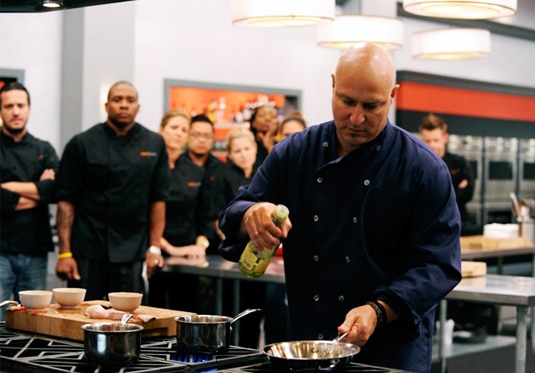
Create a free profile to get unlimited access to exclusive videos, sweepstakes, and more!
Smooth Moves
Eli Kirshtein explains what it takes to be successful in a Quickfire Challenge.

Jaguar cars have an old saying in the marketing of their sports cars, “Grace, Space, Pace.” And that in a nutshell is the key to a Quickfire. You have to have eloquence to your work, a grace and refinement, just like you do anytime you cook at professional level. Secondly you have to find space all around you. The stoves are terribly congested, all of the storage areas are a free for all that usually end up in pile-ups. Then you get to plating: the tables are very small, especially when there are two chefs per table. You have to find a way to lay out all of your plates and ingredients in a space no bigger than a large coffee table book. Then there is pace. You are on the clock, always conscious of it ticking away behind your head. You have to start conceptualizing the moment you hear the challenge, peering around the kitchen for ideas and inspiration. Then of course there is prep and cook time. You then have to plate, a whole lot of steps to cover in very short amounts of time. Personally I would make sure that I was getting food on the plate with no less than five minutes left, much more and you can find yourself in a world of trouble. So time is always on your mind.
I was very impressed with Tom’s ability to execute some creative details that hadn’t been seen in all seven seasons. Most notably the use of a cutting board or tray to haul all of his mise en place to and from the stove, or the decision to leave his fish in the pan on his station skin side down until plating, were both unique. Now let it be given, Tom has had 99 episodes to chew on how he would do it. But at the end of the day he figured out several ways to be much more efficient. It is a huge hallmark of his excellence as a chef, and anyone who doubts celebrity chefs and their cooking abilities should look at this and marvel. He further reiterated that when he made the cognizant decision to go light the proverbial fire under the chefs during the sinking of the kitchen in the Elimination.
Chefs are also very dependent on the continuity of their own kitchens or at least conceptually similar ones. In “Western” kitchens, we depend on stoves with a familiar layout, a flat top or open burners, not the giant woks in a Chinese kitchen. Flat bottom pots and pans are the norm instead of the giant concave drums on the burners here. For many of the cooks, it might have even come across as anachronistic compared to the immersion circulators and liquid nitrogen in their more familiar settings. It’s a major culture shock to step into a kitchen like this. The difficulty with this adaptation isn’t just about the gear but about many of the techniques that they had to use. Things like unregulated deep-frying, high heat steaming, and wok cookery are very clandestine to many American chefs. There are expectations of food you will see at a dim sum service and most if not all have these techniques involved.
This was an amazingly difficult challenge, maybe the worst I can recall. The chefs persevered to the best of their ability. With the diners having a certain expectations there was little hope at success. I can just say this is one kitchen I really would not want to be in.
And to Top Chef, a great first 100 episodes, and I hope many more!
Follow me on Twitter at www.twitter.com/elikirshtein


